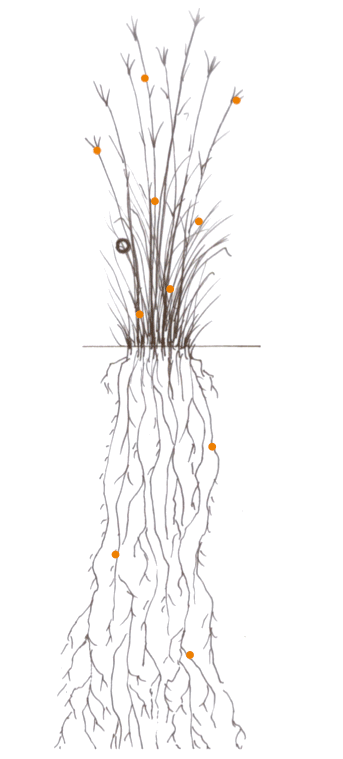
If Prairies are Never Fertilized, How can They Keep Growing?
Lawns are fertilized. Crop fields are fertilized. Pastures are fertilized. The nutrients in these fertilizers make the plants grow and produce. So, how is it that the prairies and other native grasslands keep growing when they aren’t fertilized?
Understand How Nutrients Move
Let’s imagine a nutrient (or fertilizer molecule) sitting in the soil. Let’s say it is a potassium ion. Our favorite prairie plant, let us say Big Bluestem, takes the potassium from the soil and uses it. It is used, along with other nutrients to construct the plant’s various parts such as leaves, stems, roots, flowers, and seeds.
Nutrients are Taken Up by the Roots of the Plant
Potassium, represented by the orange dots, is used along with other nutrients for growth by the plant. While the plant is still living, the nutrients in the plant are not available for other uses.

Nutrients are Stored for Later & Recycled
The frost of fall has arrived for our favorite Big Bluestem plant, and this causes the plant to become dormant. While the root system is still alive, the above-ground growth dies. Over time, the microscopic organisms in the soil consume the dead plant parts and in the process once again release the nutrients into the soil.
Potassium, again represented by the orange dots, is recycled and once again sitting in the soil.

Recycled Nutrients May be Used by Other Plants
The recycled nutrients are ready to be used, at this point, by another actively growing plant. If they are not used quickly, they can be lost from the soil; some nutrients are lost via leaching (washing out of the soil) while others can be lost through volatilization (turning into a gas and going into the air). However, in a truly diverse native grassland, there is something growing throughout the year. In this way, the nutrients are recycled from one plant to the next and may be used multiple times in the growing season.
The orange dots represent potassium and show how after being recycled from the Big Bluestem they are taken up by a different plant that grows in the cool season of the year.

So, How do Prairies Keep Growing Without Fertilizer?
So, part of the answer to the mystery of prairies and the fact that they keep growing without fertilizer is nutrient recycling. Another part of the mystery is that the native plants have “secret fertilizer factories”. They work in conjunction with rhizobia bacteria and mycorrhizal fungi to obtain nutrients that they cannot obtain without the help of these microorganisms; read more about this part of the mystery.
The Story of Cox Prairie
There is a diverse native grassland that has never been plowed near Mt. Vernon, MO (west of Springfield) that was owned for many years by the Cox family (it is now called Linden’s Prairie and owned by the MO Prairie Foundation). As Jessie Cox tells the story, the prairie has been hayed every other year for the past 30 years. For the 65 years before that, it was hayed every year. During those 95 years, almost nothing was done to replace the nutrients removed each year in the hay bales; it was limed only one or two times. Still, this prairie is growing. With the last haying, it was still producing 1.25 tons/acre, which is not a stellar yield, but I’m not aware of any other mix of plants in Missouri that can be hayed for 80 years with basically no fertility added and produce that kind of yield. A fescue pasture won’t do it. The prairie is a beautiful grassland with many wildflower and grass species. It is a testament to the ability of a diverse native grassland to recycle nutrients and work with microorganisms to “make” other nutrients.
The Benefits of Good Nutrient Cycling
Encouraging good nutrient recycling in a diverse native grassland benefits folks who are producing forage because a fertilizer ion can be used multiple times per season, and in the end it can produce more forage. Wildlife enthusiasts find that good nutrient cycling makes for nutritious seeds and foliage that feed the wildlife during seasons of the year. Recycling the nutrients from a spring blooming plant to a fall bloomer should enthuse anyone who is inspired by wildflower blooms. Finally, nutrient recycling in a diverse native grassland is a natural part of the system and can be appreciated by anyone who has an appreciation for the diverse native grasslands that once blanketed large portions of the landscape.


